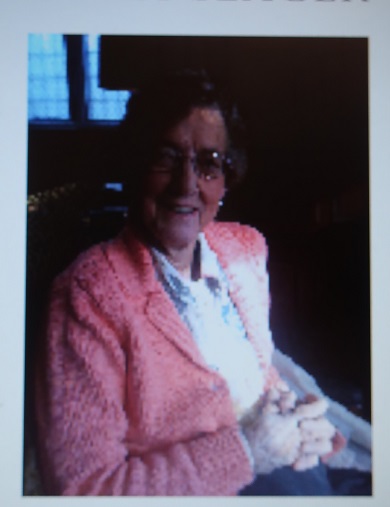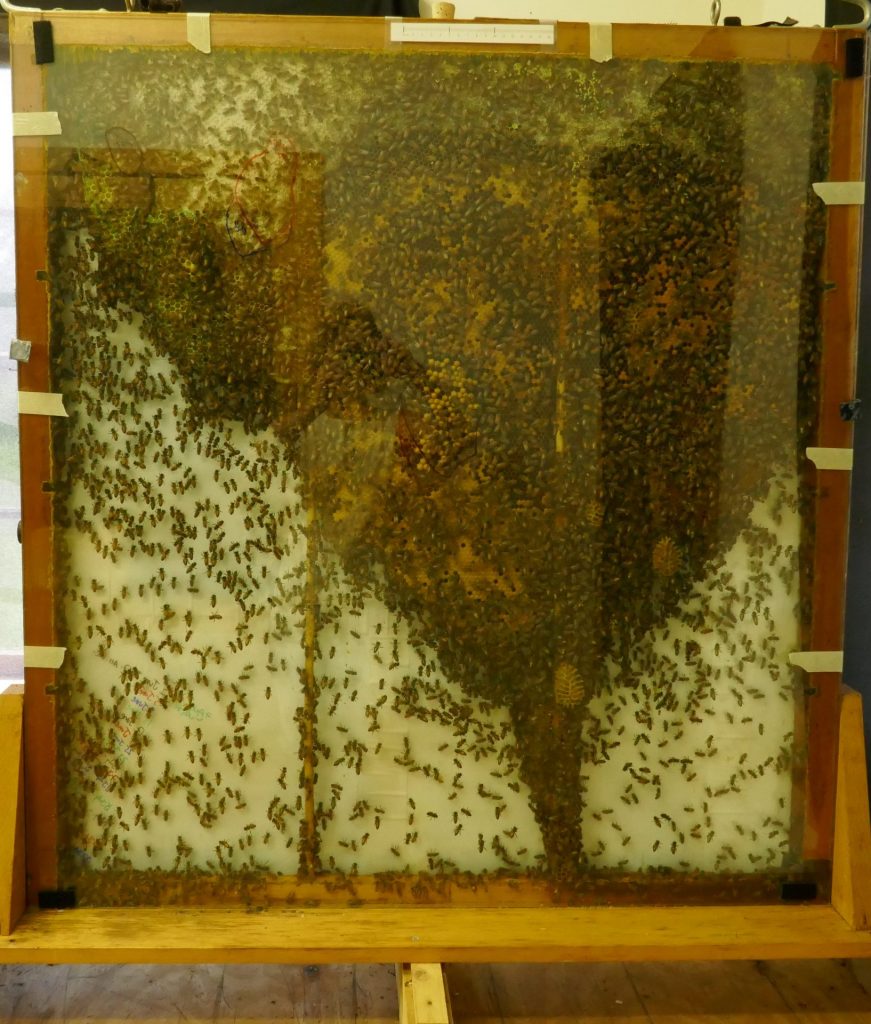
Introduction.

A few years ago on one of my visits to the US, I was shown around the bee lab at Cornell University by Dr Michael Smith who was studying comb building at the time and had magnificent observation hives in place. Michael talked about how M. Delia Allen’s research in Scotland had informed some of his current work and I was ashamed to say that I had never heard of her.
Since then, I have read some of her papers but found out very little about her life and history. Keen to learn more, I asked beekeeping historian Taylor Hood if he had time to investigate Delia’s history for me. The following guest blog is another of Taylor’s excellent glimpses into the past, and it’s exciting to discover significant women in science at a time when the profession was largelydominated by men.
Thank you, Taylor, for taking the time to investigate and share this valuable information with us in your guest blog.
Delia Allen.
Like many other significant beekeepers who have made notable contributions to beekeeping over the years, memory of scientist Delia has faded.
Delia Allen was a research scientist based at the Beekeeping Research Department, North of Scotland College of Agriculture, Marischal College, Aberdeen. She was a colleague of Dr Jeffree who also worked at the college. Most of her research was carried out from around 1955 to 1965.
PhD.
Delia Allen was awarded a PhD. from London University in 1958 – her thesis was entitled: – A study of some Activities of the Honey bee. It was in two parts.
Part 1: – Behaviour of honey bees with particular reference to the queen and swarming which includes a study of the activities and ages of the queens’ attendants and investigation into the SHAKING of both queen and workers and a description of the events preceding the departure of swarms.
In a talk to Glasgow and District Beekeepers’ Association in 1963, Dr Allen talked about how she made her observations. Bees were marked on the left side of the thorax with colour to monitor the age they had emerged and marked on the right side to represent the functions they were carrying out.
From these observations, Dr Allen discovered that bees from day 1 to day 21 after emerging could feed the queen but that it was mostly bees aged between day 6 and day 12 that fed the queen, the same age range as nurse bees, Dr Allen concluded that the queen was most probably fed brood food.
She observed that the queen laid eggs in batches of 15 and then rested and that this was the period when most feeding and grooming took place and that there were many more attendant bees around the queen at this time. Most of these attendant bees did not touch the queen but pointed their antennae towards her while others fed and preened the queen. She postulated that some form of communication was going on with the bees that were pointing their antennae towards the queen.
She found that feeding the queen peaked around mid-June.
In the hive she noticed certain bees were more active than others and that some bees did nothing for long periods. They were perhaps conserving energy when their work was not needed or required. During this time, other bees patrolled the hive carrying out jobs that were necessary.
Shaking Signal.
Dr Allen observed shaker bees and carried out studies on this observation. She observed that a bee would start shaking another bee in an up and down motion, then the bee would miss a few bees then repeat the same with another bee. She noticed that no shaking occurred at night or at day break. The shaking started at around 10 am and continued until the evening. She found that little shaking occurred through the winter.
She also observed that the queen was shaken – this started in May and reached a climax before supersedure or when swarming took place. She discovered that virgin queens were shaken before mating and that the shaking increased until mating occurred then gradually stopped about 1 week after mating. She postulated that shaking was a form of communication and most likely a mechanism to stimulate flight.
Thesis.
Part 2 of her thesis was on Respiration Rates of Honeybees.
Research Papers.
The first paper I can find where Dr Allen is cited is in The British Journal of Animal Behaviour 1955 Vol. 3 No 2 p66 -69 The Honeybee Queen and her attendants – Observations on Honeybees attending their Queen. Then in 1956 she wrote a paper in The British Journal of Animal Behaviour on The Behaviour of Honeybees preparing to Swarm Vol. 4(1) p 14-22.
Another paper was printed in 1956 in The Journal of Economic Entomology 1956 vol. 49 pages 723-726. It was titled: – The Influence of colony size and of Nosema disease on the rate of population loss in honeybee colonies in winter. It was co-authored with Dr Jeffree.
The first publication of Allen’s in the Scottish Beekeeper was in September 1957, page 157, again co-authored with Dr Jeffree, and titled – An Optimum Wintering Size for honeybee colonies.
Swarm Control Method.
In the May 1961 edition of The Scottish Beekeeper (SB) an article, co-authored with Dr Jeffree, called Simplified Method of Swarm Control was published.
The system was based on removing 3 frames of brood including eggs and young larvae without bees and putting them into a new brood chamber which was made up with frames of drawn comb or foundation. The original brood chamber was then set aside and the new brood chamber put on the original floor in the original position of the hive. A division board was put on top of this chamber, with the entrance to the back of the original hive entrance. The flying bees would then go to the lower brood chamber with the 3 frames of brood and rear a new queen. The colony in the top box would be depleted of flying bees so the chance of swarming was greatly reduced. In the autumn the two colonies were united, with the chosen preferred queen, in preparation for the winter.
Further Research.
In the January 1964 edition of the SB, Allen’s A Review of Some Recent (Bee) Research Work was published.
As well as looking into the seasonal fluctuations in the incidence of acarine (tracheal mite) and Nosema disease, Dr Allen was also involved in the research of drone behaviour and the seasonal fluctuations of drone brood.
When Dr Jeffree resigned as convener of the Scottish Beekeepers’ Association (SBA) Research Committee in 1961 (He moved to England at this time), Delia was co-opted onto the SBA Research committee and was an elected member of this committee until 1965. She was a member of the SBA from 1962 until 1965.
Social History.
After this period, I cannot find any further articles written by Dr Allen and there is no record of what happened to her. Perhaps someone who reads this article will be able to fill in the gaps. Research into her life suggests that she got married and became Dr M. Delia Seager. Delia Seager was born in 1929, and died November 2010 (in the Stoke / Staffordshire Area). She got married on the 2nd of April 1965 in Aberdeen and moved to Kinlochleven.
Mrs Delia Seager of “Cullaig” Edencoile,Kinlochleven, Argyll was an Annual Associate member of the SBA from 1966 to 1970, but not in 1965 or from 1971 onwards). Delia Seager had a daughter Marian in 1967, and two years later her husband died.
Delia Seager was an Associate Editor of the Journal of Apicultural Research part of the Bee Research Association from January 1970 to August 1977.
The Delia Seager Fund.
In conjunction with Aberdeen and District Beekeepers Association (ADBKA),The Delia Seager Fund was established in 2013 from a donation by the Aberdeen Friends’ Church for Delia Seager’s professional interests in beekeeping. The money was used to buy a number of the SBA booklets on “An introduction to Bees and Beekeeping” which were then given to new beekeepers attending the Aberdeen and District Beekeepers’ Association (ADBKA) beginner course.
Contributions to Research & Beekeeping.
Dr Allen made a significant contribution to bee research and beekeeping and it is important that we do not forget this contribution, or the work she carried out.
Acknowledgements.
Thanks to Malcolm Watson Secretary of ADBKA for some useful information on Delia Seager.
References.
I have listed some of the papers/ articles of Dr Allen so that you can read them if you are interested.
ALLEN, M. D. (1955) The Honeybee Queen and her attendants – Observations on Honeybees attending their Queen. Brit.J.Anim. Behav. 3(2): 66-69 ALLEN, M. D. (1956) The behaviour of honeybees preparing to swarm. Brit.J.Anim. Behav. 14:22
ALLEN, M. D. 1958) Drone brood in honey bee colonies. J. econ. Ent. 51: 46-48
ALLEN, M. D. (1963) Drone production in honeybee colonies (Apis mel/ifera L.). Nature, Lond. 199: 789-790
ALLEN, M. D. (1965) The effect of a plentiful supply of drone comb on colonies of honeybees. J. apic. Res. 4(3): 109- 119
Allen, M.D. (1965) J of Apic. Res. 4(3): 121-141
ALLEN, M. D. & JEFFREE, E. P. (1956) The influence of stored pollen and of colony size on the brood rearing of honeybees. Ann. app [. Bioi. 44: 649- 656
JEFFREE, E. P. & ALLEN, M.D. (1957) J. econ. Ent. 50: 211-2122 The annual cycle of pollen storage by honey bees.

Fascinating! Thank you for putting all this together for us.
Yates Notes feature Dr Jeffree on pages 66, 96 and 274 concerning the ideal size of colonies for overwintering.
You are welcome, Margaret. I am pleased that the blogs interest you so much.Best wishes, Ann.
Thanks Taylor, great stuff! I was particularly interested in the swarm control method and also the age of the workers that make up the queen retinue. Thanks Ann also.
Cheers,
Gordon
Hello Gordon. I hope that things are going well in Canada this season. Glad you enjoyed Taylor’s excellent blog. Best wishes, Ann.
Thank you for assembling this information about Dr. M. Delia Allen. Having long admired her careful, observational studies of how the workers shake the queen in preparation for swarming, I have long wished I knew more about who she was. It is admirable how she began publishing her findings when she was 26 years old, working at the North of Scotland College of Agriculture, outside Aberdeen. Also lovely to learn that she eventually used this careful work to earn a PhD in England. Given that her daughter’s first name was Marian, I wonder if Marian was also the first name of Dr. M. Delia Allen. Thanks again for your sleuthing and reporting.
Thanks for your comments on the article. I believe her first name was Mary.
Thank you, Tom.
Thank you, Taylor. Good to know.
Glad you enjoyed the blog Tom.
It is sad we have to pay so much to read a paper sometimes. I have just be quoted over £1000 to access JEFFREE, E. P. & ALLEN, M.D. (1957) J. econ. Ent. 50: 211-2122 “The annual cycle of pollen storage by honey bees”. All the options were for using the article or parts of it in some way.
I agree Margaret Anne.